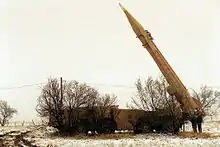Al Hijarah (missile)
The al-Hijarah missile was an Iraqi liquid propelled inertial Short-range ballistic missile, it was also a Scud missile and considered an upgrade of the al-Hussein missile equipped with chemical warheads.[1][2] It was developed by 1990[3] and was first used in the Persian Gulf War where the al-Hijarah missile would release poison clouds and kill personnel on grounds as well as ignite oil wells.[1][2] One al-Hijarah missile was confirmed to have been fired at Israel during the Gulf War where one landed near Dimona, it was revealed that the missile had a concrete filled warhead.[1]
| al-Hijarah | |
|---|---|
| Type | Short-range ballistic missile |
| Place of origin | Iraq[1][2][3][4] |
| Specifications | |
| Payload capacity | 100-300 kg[3][4] chemical warhead |
| Propellant | Liquid-propelled[4] |
Operational range | 700-900 km[3][4] |
Guidance system | Inertial |
| References | |
Characteristics
The al-Hijarah missile warhead was probably filled with chemical weapons and biological weapons possessed by Iraq at that time like anthrax, botulinum toxin, aflatoxin, sarin, cyclosarin and VX nerve agent.[2] The al-Hijarah missile being a version of the al Hussein also suffered from flight instability and improper guidance.[4] Iraq itself at that time was almost fully indigenous when it came to ballistic missile components and only lacked the ability to locally manufacture Gyroscopes.[1][2]
References
- "Al Hussein/al-Husayn". Federation of American Scientists. Archived from the original on 2 September 2019.
- "Al Hussein/al-Husayn". GlobalSecurity.org. Archived from the original on 26 January 2019.
- "Ballistic Missiles in Iran's Military Thinking". Wilson Center. Archived from the original on 22 May 2020.
- "Iraq". NTI. Archived from the original on 31 October 2019.
